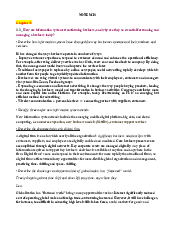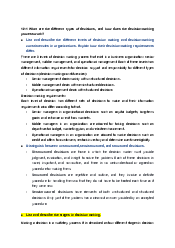




Preview text:
Using the Internet to buy or sell goods is called: A) e-commerce. D) an extranet. B) e-business. E) e-government. C) an intranet.
Which of the following is not a business benefit of collaboration? A) Improved quality D) Improved innovation
B) Improved financial performance
E) Improved compliance with government C) Improved customer service regulations
Which of the following is a routine question that might be answered by an MIS system? A) Creating a new product
B) Estimating the effect of changing costs of supplies
C) Calculating the best trucking routes for product delivery
D) Compare planned to actual sales for each quarter
E) Forecasting new industry trends
Which type of system integrates supplier, manufacturer, distributor, and customer logistics processes?
A) Collaborative distribution system D) Enterprise planning system
B) Supply chain management system
E) Transaction processing system C) Reverse logistics system
All of the following are capabilities of enterprise social networking tools except:
A) the ability to set up member profiles.
B) the ability to share, store, and manage content.
C) the ability to establish groups and team workspaces.
D) tagging and social bookmarking. E) supply chain management.
Which of the following statements about collaboration is not true?
A) In business, a collaboration can last as little as a few minutes.
B) Business collaboration relies on the formation of teams that are assigned a specific task or goal.
C) Successful collaboration can be achieved through technology regardless of the organization's culture or structure.
D) One business benefit of collaboration is improved innovation.
E) Businesses need special systems for collaboration. technologies do they use?
Along with capital, ________ is the primary production input that the organization uses to 1 create products and services. A) structure D) feedback B) culture E) labor C) politics
Which of the following statements about organizations is not true?
A) An organization is a stable, formal social structure that takes resources from the environment
and processes them to produce outputs.
B) An organization is a formal, legal entity with internal rules and procedures that must abide by laws.
C) An organization is a collection of people and other social elements.
D) An informal group can be considered to be an organization.
E) An organization is a collection of rights, privileges, obligations, and responsibilities delicately
balanced over a period of time through conflict and conflict resolution.
All of the following statements are true about information technology's impact on business firms except:
A) it helps firms expand in size.
B) it helps firms lower the cost of market participation.
C) it helps reduce internal management costs.
D) it helps reduce transaction costs.
E) it helps reduce agency costs.
According to research on organizational resistance, the four components that must be
changed in an organization in order to successfully implement a new information system are:
A) environment, organization, structure, and tasks.
B) technology, people, culture, and structure.
C) organization, culture, management, and environment.
D) tasks, technology, people, and structure.
E) costs, tasks, structure, and management. The value chain model:
A) categorizes five related advantages for adding value to a firm's products or services.
B) sees the supply chain as the primary activity for adding value.
C) categorizes four basic strategies a firm can use to enhance its value chain.
D) highlights specific activities in the business where competitive strategies can best be applied.
E) enables more effective product differentiation. A virtual company:
A) uses networks to link people, assets, and ideas.
B) uses Internet technology to maintain a virtual storefront.
C) uses Internet technology to maintain a networked community of users.
D) provides entirely Internet-driven services or virtual products.
E) is limited by traditional organizational boundaries. 2
Which model is used to describe the interaction of external forces that affect an
organization's strategy and ability to compete? A) Network economics model D) Demand control model B) Competitive forces model E) Agency costs model C) Competitive advantage model
The obligations that individuals and organizations have concerning rights to intellectual
property involve which of the following moral dimensions of the information age?
A) Property rights and obligations
D) Information rights and obligations B) System quality E) Quality of life C) Accountability and control
Which of the following is not one of the current key technology trends that raises ethical issues? A) Data storage improvements
D) Increase in use of mobile devices B) Data analysis advancements
E) Advances in networking technology C) Increase in data quality
Which of the following ethical guidelines suggests that you put yourself in the place of
others, and think of yourself as the object of the decision?
A) Kant's categorical imperative D) the Golden Rule B) the risk aversion principle E) the "no free lunch" rule C) the utilitarian principle
Which of the following best describes the effect that new information technology has on society?
A) It has a dampening effect on the discourse of business ethics.
B) It has a ripple effect, raising new ethical, social, and political issues.
C) It is beneficial for society as a whole, while raising dilemmas for consumers.
D) It has a waterfall effect in raising ever more complex ethical issues.
E) It has a magnifying effect, creating increasing numbers of ethical issues.
________ is a feature of social institutions that means mechanisms are in place to determine responsibility for an action. A) Due process D) The judicial system B) Accountability E) Liability C) The courts of appeal
Which of the following statements about spam is not true?
A) Most spam originates from bot networks.
B) Cell phone spam usually comes in the form of SMS text messages.
C) Spam costs for business are very high.
D) Spamming has mushroomed because it is so inexpensive and can reach so many people. 3
E) Spamming is more tightly regulated in the United States than in Europe.
All of the following are technical solutions to protecting user privacy except: A) email encryption.
D) preventing client computers from B) anonymous surfing. accepting cookies. C) anonymous email. E) data use policies.
Which of the following is not an IT infrastructure service component? A) Operating system software
B) Computing platforms to provide a coherent digital environment
C) Physical facilities management to manage the facilities housing physical components
D) IT management services to plan and develop the infrastructure and provide project management
E) IT education services that provide training to employees
________ uses individual atoms and molecules to create computer chips and other devices. A) Virtualization B) Nanotechnology C) Quantum computing D) A minicomputer E) On-demand computing
Which of the following is not one of the six strategic business objectives of information systems? A) New products and services D) Competitive advantage B) Improved decision making E) Survival
C) Improved community relations
A firm that invests in an information system because it is a necessity of doing business does so
because it is seeking to achieve which of the following business objectives? A) Operational excellence D) Customer intimacy B) Improved decision making E) Survival C) Competitive advantage
To make sure they stock clothes that their customers will purchase, a department store 4
implements a new application that analyzes spending levels at their stores and cross-references
this data to popular clothing styles. Which of the following business objectives is this
information intended to support? A) Customer intimacy D) Improved decision making B) Survival E) New products and services C) Operational excellence
In a hierarchical organization, the upper level consists of: A) scientists. D) data workers. B) senior management. E) knowledge workers. C) professional employees.
The three activities in an information system that produce the information organizations use to control operations are:
A) information, research, and analysis.
D) data analysis, processing, and feedback.
B) input, output, and feedback.
E) input, processing, and output.
C) data, information, and analysis.
Converting raw data into a more meaningful form is called: A) capturing. D) feedback. B) processing. E) analysis. C) organizing.
Which main business function is responsible for maintaining employee records? A) Sales and marketing
D) Manufacturing and production B) Human resources E) Middle management C) Finance and accounting
The ________ function is responsible for making sure customers are aware of the company's products. A) finance and accounting D) sales and marketing B) human resources E) distribution and logistics
C) manufacturing and production 5




